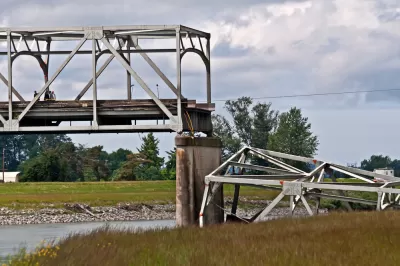Failing infrastructure is a life and death matter. Decaying roads, bridges, dam, pipelines, water delivery, and railroads lacking safety controls are responsible for the loss of thousands of lives annually, on top of illnesses and injuries.

"From coast to coast, the country’s once-envied collection of bridges, dams, pipelines, sewage treatment plants and levees is crumbling," writes Ron Nixon for The New York Times. "Studies have shown that a lack of investment in public infrastructure costs billions of dollars a year in lost productivity, as people sit in traffic or wait for delayed shipments."
However, costs go far beyond congestion. Public health, safety, and life itself are at stake. "Every year, hundreds of deaths, illnesses and injuries can be attributed to the failure of bridges, dams, roads and other decaying structures," writes Nixon.
The federal Department of Transportation (DOT) estimates that obsolete road designs and poor road conditions are a factor in about 14,000 highway deaths each year. Research by Ted Miller, a senior research scientist at the Pacific Institute for Research and Evaluation, which receives financing from the Transportation Department, put the medical cost of highway injuries from poor road conditions at $11.4 billion for 2013, according to the latest data available.
Nixon also writes about the loss of life due to other infrastructure failures including the lack of Positive Train Control for railroads, natural gas pipeline explosions, recent dam failures, disease outbreaks from "aging and crumbling water systems."
Much of America’s infrastructure was built many decades ago with the understanding that the structures would remain in place for no more than 50 years or so. But many structures have exceeded that age.
The six-year STRR Act that passed the House on Nov. 5 and the six-year DRIVE Act that passed the Senate on July 30 only keep transportation spending at current levels, adjusted for inflation, falling "far short of what many infrastructure experts say is needed, both in terms of time and money," notes Nixon.
“There is no question that there are safety impacts and loss of life because we didn’t take the time or spend the money to make infrastructure what it should be,” Anthony R. Foxx, the transportation secretary, said in an interview.
Joan Lowy of The Associated Press writes that Secretary Foxx indicated that a minimum of $400 billion over six years is needed. The STRR Act authorizes $325 billion, notes Lowy, though only has funds for the first three of the six years.
"President Obama, in his budget, had called for a larger, $478 billion program," writes
FULL STORY: Human Cost Rises as Old Bridges, Dams and Roads Go Unrepaired

Americans May Be Stuck — But Why?
Americans are moving a lot less than they once did, and that is a problem. While Yoni Applebaum, in his highly-publicized article Stuck, gets the reasons badly wrong, it's still important to ask: why are we moving so much less than before?

Study: Maui’s Plan to Convert Vacation Rentals to Long-Term Housing Could Cause Nearly $1 Billion Economic Loss
The plan would reduce visitor accommodation by 25,% resulting in 1,900 jobs lost.

Placekeeping: Setting a New Precedent for City Planners
How a preservation-based approach to redevelopment and urban design can prevent displacement and honor legacy communities.

San Diego Swaps Parking Lane for Kid-Friendly Mini Park
The block-long greenway will feature interactive play equipment and landscaping.

Tracking the Invisible: Methane Leaks From LA’s Neighborhood Oil Sites
Environmental advocates are using infrared technology to monitor and document methane leaks from neighborhood oil sites, filling regulatory gaps and pushing for stronger protections to safeguard community health and the climate.

Montana Bill Promotes Parking Reform
A bill before the Montana state senate would bar cities from requiring more than one parking spot per new housing unit.
Urban Design for Planners 1: Software Tools
This six-course series explores essential urban design concepts using open source software and equips planners with the tools they need to participate fully in the urban design process.
Planning for Universal Design
Learn the tools for implementing Universal Design in planning regulations.
Caltrans
Heyer Gruel & Associates PA
Institute for Housing and Urban Development Studies (IHS)
City of Grandview
Harvard GSD Executive Education
Salt Lake City
NYU Wagner Graduate School of Public Service
City of Cambridge, Maryland


























